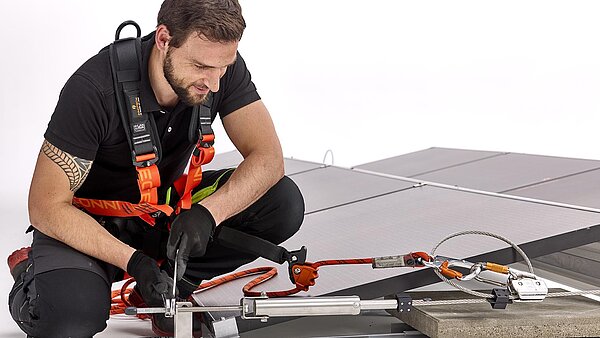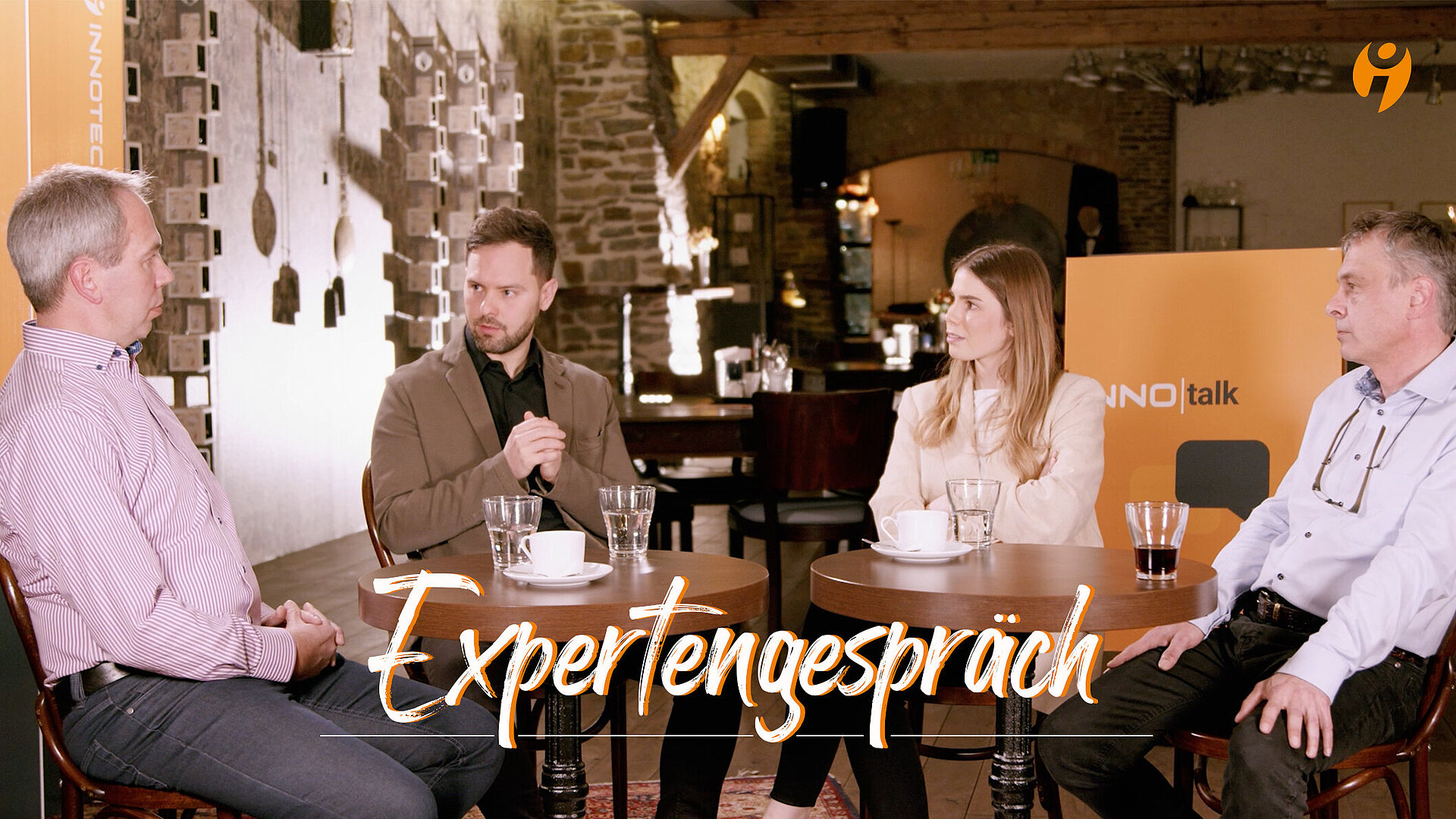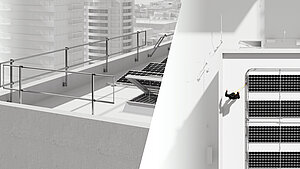The decision in favour of a PV system on a roof creates numerous questions regarding the optimum use of the roof surface in order to generate as much solar power as possible. But this also triggers many core questions regarding the subject of safety during the installation of the solar power plant, and during regular servicing and cleaning tasks. But remember right from the outset: a professional, certified fall protection system is a legal requirement when working on the PV installation on a roof. We invited experts to a discussion on the subject of fall protection for PV systems on flat and pitched roofs. In this blog post we go into the most frequently asked questions related to this topic.
Question 1: What are the benefits of installing the fall protection system directly onto the PV substructure?
It is of decisive importance that the safety solution on the roof does not impair the efficiency of the solar power plant. This is why there are fall protection systems which can be installed directly onto the customer’s PV substructure, and which therefore cast no shade on the panels. This in turn would reduce the efficiency of the PV system. In addition, this installation variant completely avoids roof penetrations, and the roof surface can be used optimally for the solar power plant, because this solution takes up no additional space on the roof.
Furthermore, the fall protection system, and individual modules of it, do not themselves become obstacles to any tasks on the roof. And: This combined structure secures all danger zones and access routes optimally, with the result that it can also be used as fall protection for all other tasks on the roof. For example, when the air-conditioning or the satellite dish require repair, or other activities on the roof arise. However, a prerequisite of this is the creation of a well-founded safety concept which also includes regular inspection. And naturally the fall protection system needs to be appropriately certified.
Question 2: In terms of installing a fall protection system, what are the disadvantages of penetrating the roof?
The main problem with roof penetrations is that the roof opening allows water or even moisture to enter the interior of the building in the medium or long term. In other words, there is a danger that sooner or later the roof will leak. Frequently, various anchorage devices which do not use the PV system require these roof penetrations, in order to ensure the corresponding load-bearing capacity. This in turn requires considerable effort and expense.
In such a case, a safety solution for PV systems which does not require roof penetration, i.e. is installed directly on the PV substructure, benefits everyone involved: The clients receive a complete solution from a single provider, and without opening the roof at all.
Question 3: For PV installations on a roof, which fall protection systems are even available?
There is a broad range of fall protection systems, also for photovoltaic systems. For example, lifeline and rail systems, as well as single anchor points, are attached onto or near to the PV substructure. On a pitched roof with a steep inclination, safety roof hooks can also be used to protect against falls. If the roof is flat, the deployment of guardrail protection is an option. The appropriate fall protection system for the specific PV system also depends on the roof, amongst other things. However, for a solid safety concept other parameters, such as the onsite weather conditions and potential obstacles on the roof, are of the greatest significance.
Question 4: How does a solar system installer benefit from collaborating with a certified expert in fall protection on roofs?
The benefits clearly speak for themselves. First and foremost, you have the opportunity of offering your customers a unique all-in-one package which provides an absolutely efficient PV system having the maximum possible safety. This gives you a significant advantage in expertise compared with your competitors, and PV customers certainly appreciate this. And remember that in terms of service you will also score highly with your customers.
The TOP 4 benefits at a glance:
- Positive image: With a holistic view of safety on and with PV installations, and through collaborating with an expert in fall protection, as a solar system installer you gain a decisive expertise advantage, as well as an image boost compared with your competitors.
- Working in safety: All activities on a PV system on a roof, i.e. all necessary servicing and cleaning tasks, can be performed quickly and safely at any time using a professional safety solution. Legally, this puts you as a solar system installer on the “safe” side with respect to industrial safety.
- Planning certainty: With an expert in fall protection, you as a solar system installer receive a seamless safety concept which fulfils all legal prerequisites and standards. This concept is developed specifically for the use case and the actual situation. This gives installers as well as solar technicians complete planning certainty, and the customer gets a good feeling too!
- Broad range of safety solutions: Depending on the actual situation and complexity, a number of different options are available for protection against falls. Factors such as roof inclination, the presence of skylights, closeness to the fall edge etc. affect the choice of fall protection system. An expert considers all these factors, plans a holistic concept, and even develops special solutions if required. In addition, ascents, roof hatches, roof windows, and other danger areas are also protected against falls.
Question 5: The cost factor! Is attachment of the fall protection system to the PV substructure financially attractive for my customers?
Definitely! The attachment of “normal fall protection systems” generally requires roof penetrations, and these can have a negative effect on the roof’s leak tightness. That favours a fall protection system installed directly onto the PV substructure. But regardless whether the choice is a “normal solution” or a “new attachment option”, in both cases the solar cells can be cleaned in absolute safety at any time. The result is that the PV system always runs at maximum efficiency.
This means: The purchase costs may be somewhat higher, but in the medium and long term, an integrated fall protection system is significantly more economical variant from the very start, because for one thing the roof cladding is undamaged and for another, the solar power plant can provide its maximum output at all times. It should also be remembered that - apart from the personal suffering associated with a fall - such an accident on a roof also creates costs. In addition, employees are then off work because of injury. If a subsequent inspection then also indicates that at the time of the fall the fall protection system did not comply with the legal requirements, then the consequences in terms of costs can even threaten your company’s survival, and may in fact be subject to criminal law!
Question 6: Where do I gain the knowledge to install the fall protection system appropriately and effectively?
Perfectly simple… with INNO|school from INNOTECH. Our range of courses includes a 1-day training session in fall protection systems for photovoltaic installations on a roof. This training ensures that every installation activity counts. With a balanced mix of theory and practice, the course teaches solar system installers everything they need to know about the correct planning and installation of the appropriate fall protection system, as well as the legal principles and the risks of the illusion of safety.
Summary
Bundling the know-how of INNOTECH and PV substructure manufacturers mean that installers and solar technicians become absolute full-service providers for PV systems. In this way, not only can you provide your customers with an efficient solar power plant, but on the roof you also provide it with the best possible fall protection. This integrated system, tested and certified in combination, provides absolute legal certainty in terms of industrial safety to everyone involved, and also saves lives.
Now download our guide to fall protection systems for PV installations on a roof. In it you will find numerous further aspects and more information on this subject. You will also find further information on this subject in our INNO|talk video.

By loading this video, you accept Google's privacy policy.








![[Translate to Englisch:] [Translate to Englisch:]](https://www.innotech-safety.com/fileadmin/_processed_/1/a/csm_Mehrere_PV-Kunden_gleichzeitig_betreuen__kann_oft_zur_Riesenherausforderung_werden-header_c1a520d846.jpg)
























